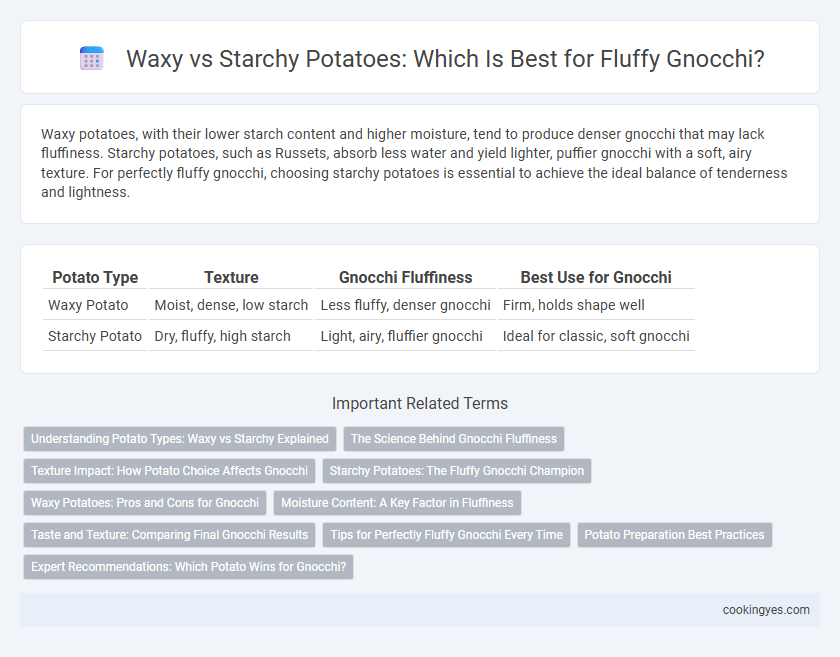Waxy potatoes, with their lower starch content and higher moisture, tend to produce denser gnocchi that may lack fluffiness. Starchy potatoes, such as Russets, absorb less water and yield lighter, puffier gnocchi with a soft, airy texture. For perfectly fluffy gnocchi, choosing starchy potatoes is essential to achieve the ideal balance of tenderness and lightness.
Table of Comparison
| Potato Type | Texture | Gnocchi Fluffiness | Best Use for Gnocchi |
|---|---|---|---|
| Waxy Potato | Moist, dense, low starch | Less fluffy, denser gnocchi | Firm, holds shape well |
| Starchy Potato | Dry, fluffy, high starch | Light, airy, fluffier gnocchi | Ideal for classic, soft gnocchi |
Understanding Potato Types: Waxy vs Starchy Explained
Waxy potatoes, like red or new potatoes, have a lower starch content and hold their shape well, making them less ideal for fluffy gnocchi. Starchy potatoes, such as Russet or Idaho, contain higher starch levels that break down easily, resulting in light and airy gnocchi texture. Choosing starchy potatoes is essential for achieving the soft, pillowy consistency characteristic of classic gnocchi recipes.
The Science Behind Gnocchi Fluffiness
The science behind gnocchi fluffiness lies in the choice of potato type, where waxy potatoes retain more moisture and starch granules, resulting in a denser, less airy texture. Starchy potatoes, such as Russets, have higher amylose content that absorbs less water, creating a lighter, fluffier gnocchi by allowing less gluten development in the dough. Properly balancing moisture and starch gelatinization during cooking ensures optimal gnocchi texture, making starchy potatoes the preferred choice for achieving a delicate, airy bite.
Texture Impact: How Potato Choice Affects Gnocchi
Waxy potatoes, such as red or fingerling varieties, have a higher moisture content and lower starch, producing denser, chewier gnocchi with a smooth texture. Starchy potatoes like Russets offer dry, fluffy interiors that absorb less water during boiling, resulting in light and pillowy gnocchi with a desirable melt-in-the-mouth quality. Choosing starchy potatoes maximizes gnocchi fluffiness by providing a delicate crumb that resists becoming gummy or heavy.
Starchy Potatoes: The Fluffy Gnocchi Champion
Starchy potatoes, such as Russets or Idaho varieties, are the ideal choice for achieving fluffy gnocchi due to their high starch content and low moisture levels, which create a lighter, airier dough. The dry texture of starchy potatoes allows them to absorb less water during cooking, resulting in gnocchi that hold their shape better and have a tender, pillowy consistency. Using waxy potatoes, by contrast, often produces denser, chewier gnocchi because of their higher moisture and lower starch content.
Waxy Potatoes: Pros and Cons for Gnocchi
Waxy potatoes, such as red or new potatoes, retain more moisture and have a firmer texture, resulting in denser gnocchi that hold their shape well during cooking. Their lower starch content makes them less likely to become mushy, but they can produce less fluffy gnocchi compared to starchy varieties like Russets. Choosing waxy potatoes for gnocchi offers the advantage of structure and bite, though it may sacrifice the light, airy texture characteristic of traditional fluffy gnocchi.
Moisture Content: A Key Factor in Fluffiness
Waxy potatoes, such as red or new potatoes, have higher moisture content and lower starch levels, which often leads to denser, less fluffy gnocchi due to excess water making the dough sticky and heavy. Starchy potatoes like Russets contain less moisture and more starch, enabling a lighter, fluffier texture as the dough binds well without excess water. Controlling moisture content by choosing starchy potatoes and properly drying them after cooking is essential for achieving optimal gnocchi fluffiness.
Taste and Texture: Comparing Final Gnocchi Results
Waxy potatoes, such as red or new potatoes, yield gnocchi with a denser, chewier texture and a slightly buttery taste, offering a firm bite that holds shape well. In contrast, starchy potatoes like russets produce fluffier, lighter gnocchi with a delicate crumb that easily melts in the mouth, enhancing the overall softness and subtle sweetness. The choice between waxy and starchy potatoes directly impacts the final taste and texture, with starchy varieties preferred for traditional airy gnocchi and waxy types suited for a heartier, more robust dish.
Tips for Perfectly Fluffy Gnocchi Every Time
For perfectly fluffy gnocchi, choose starchy potatoes like Russets or Yukon Golds, as their low moisture content creates a lighter dough. Avoid waxy potatoes such as Red or New potatoes, which are denser and retain more moisture, resulting in heavier, gummy gnocchi. Properly drying and mashing the starchy potatoes before incorporating flour enhances the gnocchi's tender, airy texture.
Potato Preparation Best Practices
Using starchy potatoes like Russets yields lighter, fluffier gnocchi due to their low moisture and high starch content, which prevents dough from becoming dense or gummy. Properly baking or boiling potatoes with skins on preserves dryness and prevents excess water absorption, ensuring optimal texture. Ricing the potatoes while hot and gently folding the dough minimizes handling, maintaining the desired fluffiness in the final gnocchi.
Expert Recommendations: Which Potato Wins for Gnocchi?
Expert chefs recommend using starchy potatoes like Russet or Idaho for gnocchi to achieve maximum fluffiness due to their low moisture and high starch content, which prevents dough from becoming gummy. Waxy potatoes, such as red or new potatoes, contain more moisture and hold their shape better but result in denser, less airy gnocchi. For light, tender gnocchi with perfect texture, starchy potatoes consistently outshine waxy varieties according to culinary experts.
Waxy potato vs starchy potato for gnocchi fluffiness Infographic

 cookingyes.com
cookingyes.com